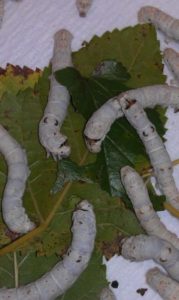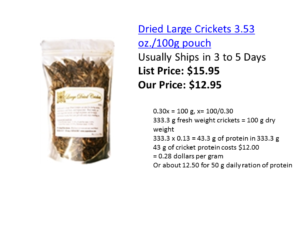In previous posts, I have discussed Questions 1) and 2) with the answers that 1) I think that getting people to eat insects will not be an insurmountable barrier and 2) there are specific concerns that must be addressed to assure people that the insects that they are eating are of proven (vetted) food value and that they are safe in accordance to food safety guidelines. I expressed special concern about getting right the analytical methods that provide information for food labels (proximate analyses) of insects to be used as food AND I suggested that careful scientific experiments needed to be done to demonstrate the efficacy and bio-availability of insects on a per case basis (i.e., what we learn about how bio-available cricket protein may be for humans does not translate exactly to the bio-availability of mealworms or some other insects.
This leads to my third question from the paragraph in the original blog post on eating insects: gathering vs. farming.
Some Basic Questions and Organizing Principles: 1) Will social or cultural constraints make it unrealistic to use insects as human food? 2) Does the food value and food safety of insects impose impossible constraints? 3) Will gathering insects from nature allow us to make a significant “dent” in the needs for human food? 4) Will systems of farming insects become feasible to make significant advances in the use of insects as human foods? 5) How far can insect mass-rearing go towards allowing us to produce enough quality insect biomass to have a significant impact on the growing needs for food?
In the FAO-sponsored paper by van Huis et al. 2013, the authors make a case for the wide-spread acceptance and cultural tradition of using insects as food for people. The photographs in this publication are dazzling, and the presentation of the insects makes them most appetizing. However, most of the insects depicted in this paper are gathered (harvested from nature or as side-products from agriculture. At this level of making insects available, there is total dependence on existing populations of insects, just as fishing and hunting are used to provide human food from the oceans, fresh water, and from the wild, in general. Clearly there problem with reliance on gathered insects will meet with the same barriers that fishing and hunting have met when human populations rose to levels that exceeded the supply from nature alone.
Of course, this gave rise to agriculture. So the next step that far-thinking “insects as food advocates” suggest is agricultural production of insects: farming insects to be used as human food. There are several possible forms of “insect farming:” 1) field operations where production takes place in agricultural fields or in greenhouses, 2) production of feeder insects as side-products of existing programs or insect production that is in place with other functions, and 3) in systems where insects are reared for food purposes as the primary goals.
- Producing edible insects as a field operation: often our mono-culture system of agriculture results in production of large biomasses of insects that are pests in our crops. So a possible avenue for mass-production of insects in the field could be a controlled locust swarm where an optimized crop of grass could be grown to deliberately serve as a food for locusts, which would be harvested at appropriate times. Buildups of locusts and other crop pests take place NOT under human control. If the pests’ biology could be better understood with all the conditions that lead to massive pest outbreaks managed, this could be a low-input form of insect farming. Obviously, this is a speculative issue, and much, much more understanding of the natural cycles of pest build-up must be developed.
- The production of feeder insects as an outgrowth of existing insect production systems has the advantage that a substantial base of knowledge exists for producing certain kinds of insects. Silkworms have been domesticated for 5000 years, and their mass- production for silk has long been a practice throughout Asia and more recently, the Middle-East and parts of Europe (and even in the Americas to a limited extent). It happens, too that silkworms are already a well-accepted food for people, and the pupae, once they have spun their cocoon, can be harvested for food for people. If the cost of producing silkworms were further reduced with an artificial diet technology that could replace the mulberry with a cheaper food while retaining the mulberry flavor with an extract, it is possible (though challenging) to greatly increase silkworm production, make silk less expensive, and make considerable biomass of tasty silkworm pupae available. Honeybee drones have been used as as food for people and other organisms, and the cost of producing drones is supplemented by the use of honeybees as 1) pollinators, 2) sources of honey, 3) sources of wax, and 4) other products that can be value-added ALONG WITH DRONES AS HUMAN FOOD. Again, like with silkworms, this possibility would call for development of technology that would reduce the cost of amplifying bee populations. In light of the current problems with colony collapse disorder (CCD), this prospect seems challenging, but I feel that too little is understood about nutritional replacements of pollen and nectar, so I can see a possible increase in honeybee production.
- Some other insects that are currently produced as feeders, include crickets and meal worms, drosophilid flies, horn worms, among others. Improvements in mass-rearing these and other potential feeder organisms, can result in reduced costs of production of feeder insects for human food. This topic requires far more discussion, some of which I will do in a future blog post. It should be noted that only a few researchers have treated with actual scientific studies the topic of the efficacy of the production and use of feeder insects as human food: this leaves most of the considerable attention that has been given to this topic in the category of speculation. An example of what I mean by scientific studies is the Lundy and Parrella (2015) paper titled, “Crickets are not a free lunch…:” These authors did a systematic study of utilization of various quality foods by crickets (Acheta domesticus). Statements in the popular literature, on websites, and in proposals for funds to support enhancement technology for producing crickets (and other feeder insects) on low quality foods, including portions of waste streams. Lundy and Parrella showed that the claims by many insects as human food advocates that crickets have a tremendous potential for turning low quality foods into high quality, high nutrient insect biomass. These authors showed that there are definite limitations to crickets’ ability to make the kind of conversions that they are often touted to make. I will treat this concept of how much we should expect from insects to make the nearly magical transformations in a near future blog post on the virtually alchemy expectations that are touted for insects.
Lundy M. E., Parrella, M. P. (2015) Crickets Are Not a Free Lunch: Protein Capture from Scalable Organic Side-Streams via High-Density Populations of Acheta domesticus. PLoS ONE 10(4): e0118785. doi:10.1371/journal.pone.0118785
van Huis A, van Itterbeeck J, Klunder H, Mertens E, Halloran A, Muir G, et al. Edible insects: future prospects for food and feed security. No. 171. Food and Agriculture Organization of the United Nations (FAO), 2013.



